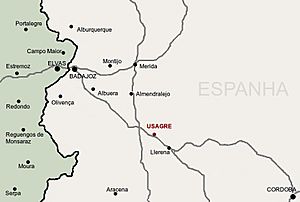Battle of Usagre facts for kids
Quick facts for kids Battle of Usagre |
|||||||
|---|---|---|---|---|---|---|---|
| Part of the Peninsular War | |||||||
 Battle of Usagre |
|||||||
|
|||||||
| Belligerents | |||||||
| Commanders and leaders | |||||||
| Strength | |||||||
| 3,500 | 2,000 6 guns |
||||||
| Casualties and losses | |||||||
| 250 killed, wounded or captured | 20 killed, wounded or captured | ||||||
The Battle of Usagre was a cavalry fight that happened on May 25, 1811. It took place near the village of Usagre in Spain. This battle was part of the larger Peninsular War.
In this battle, cavalry (soldiers on horseback) from Britain, Portugal, and Spain fought against French cavalry. The British-led forces were commanded by Major-General William Lumley. The French forces were led by Major-General Marie Victor Latour-Maubourg. The battle ended with a victory for the British and their allies.
Contents
Why the Battle Happened
Just a week before Usagre, there was a very tough battle called the Battle of Albuera. After that battle, a French leader named Marshal Nicolas Soult sent his cavalry. Their job was to find out where the Allied army was located. The Allied army was led by Marshal William Carr Beresford.
On May 25, 1811, the French cavalry found some Portuguese cavalry guards. These guards were on a ridge (a long, narrow hill) behind Usagre village. Major-General Lumley, who led the Allied cavalry, cleverly hid most of his soldiers behind this ridge. This way, the French couldn't see how many soldiers he had.
Who Fought in the Battle?
General Lumley's forces were made up of different cavalry groups:
- British Cavalry: About 980 soldiers from the 3rd Prince of Wales Dragoon Guards and the 4th Queen's Own Dragoons. Also, the 13th Light Dragoons.
- Portuguese Cavalry: About 1,000 soldiers from the 1st and 7th Dragoons, plus parts of the 5th and 8th Dragoons.
- Spanish Cavalry: About 300 soldiers led by Penne Villemur.
- Artillery: They also had some cannons from Lefebvre's Troop, Royal Horse Artillery.
In total, Lumley had about 2,000 cavalry soldiers and 6 cannons.
The French forces were led by General Latour-Maubourg. He had about 3,500 cavalry soldiers, which was more than Lumley's forces.
- French Dragoons: Two groups of dragoons (soldiers who could fight on horseback or on foot). These included the 4th, 20th, 26th, 14th, 17th, and 27th Dragoons.
- Light Cavalry: Four regiments of light cavalry were sent to try and go around the Allied forces.
Latour-Maubourg felt confident because he had more soldiers. So, he decided to attack.
The Battle Unfolds
General Lumley knew that the French light cavalry trying to go around them wouldn't arrive in time to help. He waited for the main French cavalry to cross a bridge in Usagre.
- French Advance: Two French dragoon regiments (the 4th and 20th) rode through Usagre. They crossed the bridge and got ready on the other side.
- Lumley's Attack: As the 26th Dragoons started to cross the bridge, Lumley gave the order to attack! He brought his cavalry forward. Six British squadrons (groups of cavalry) charged. Six Portuguese squadrons supported them on their right side. They attacked the two French regiments that had already crossed.
- French Retreat: The French cavalry were quickly defeated. They were pushed back towards the 26th Dragoons, who were still stuck on the bridge. With British cavalry all around them and their way back blocked, the French soldiers were trapped.
- Desperate Measures: Latour-Maubourg had to act fast. He ordered some of his dragoons to get off their horses. They tried to hold the houses near the bridge to protect the retreating soldiers. Finally, the remaining French soldiers fought their way back, helped by rifle fire from the village.
What Were the Results?
The Battle of Usagre was a clear victory for the British and their allies.
- French Losses: The French lost about 250 soldiers. These were either killed, wounded, or captured. Most of these losses came from the 4th and 20th Dragoons.
- Allied Losses: The British and their allies had very few losses. Only about 20 of their soldiers were killed or wounded.
This battle showed the skill of the Allied cavalry and their commanders.
See also
 In Spanish: Batalla de Usagre para niños
In Spanish: Batalla de Usagre para niños

